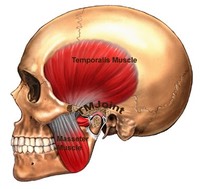Temporomandibular joint (TMJ) syndrome is a painful condition that causes inflammation in the joint created by the temporal bone in the skull and the lower jaw bone (mandible).
The primary symptom is pain with opening and closing the mouth. This pain is usually worse in the morning and is just in front of the ear. This pain can radiate to the ear, cheek, neck or shoulder. Some people also complain that their jaw catches when they open their mouth. Some people have a grating or clicking sound in their TMJ when they eat.
TMJ may be caused by head or jaw trauma (ex. direct blow or sometimes dental extractions), abnormal occlusion (teeth don't align properly), abnormalities of the articular disc, teeth grinding, anxiety, stress, tissue tensions or imbalances in the jaw, head, neck or body that put abnormal strain on the TMJ.
TMJ issues are not limited to the jaw--the entire body is afected and treatment requires a holisitc approach. The TMJ has multiple muscular, ligamentous, and fascial connections to the cervical (neck) and cranial (head) regions, forming a functional complex called the cranio-cervico-mandibular system. Abnormal tensions can alter the mechanics of the TMJ, causing abnormal closing and opening of the mouth and TMJ pain. Osteopathic manipulation can remove the tissue tensions in the jaw, head, neck, and body and thus eliminate the cause of the TMJ pain.
Additional therapies may include biopuncture or low level laser, to decrease inflammation and spasm, dental appliances, or meditation and relaxation techniques.
